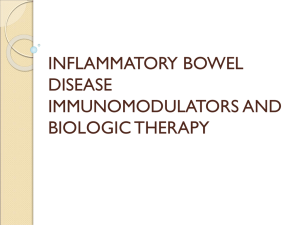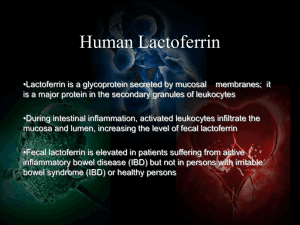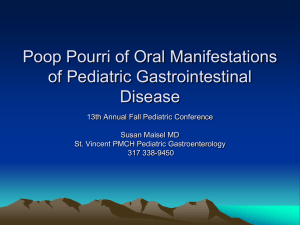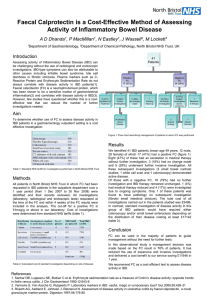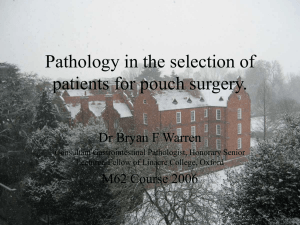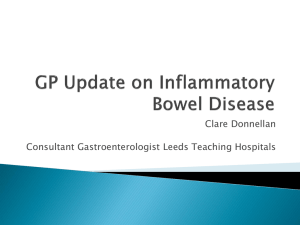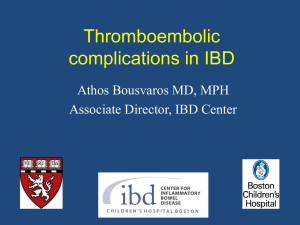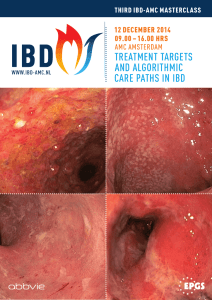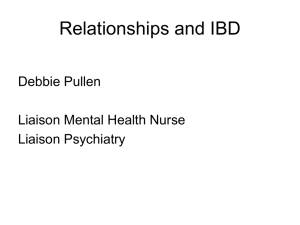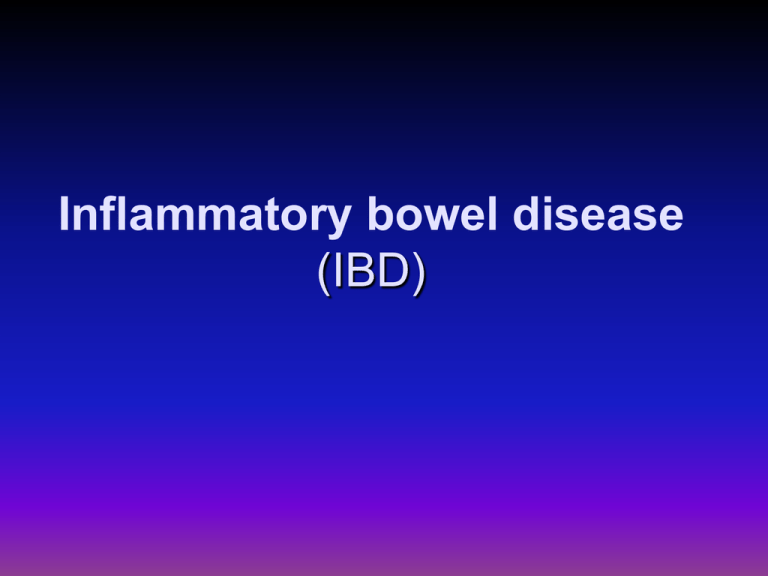
Inflammatory bowel disease
(IBD)
Epidemiology
• both occur at the highest incidence in
Europe, the United Kingdom, and North
America.
• In North America, incidence rates range
from 2.2 to 14.3 cases per 100,000
person-years for UC and from 3.1 to 14.6
cases per 100,000 person-years for CD
Epidemiology
• The peak age of onset of UC and CD is between
15 and 30 years.
• A second peak occurs between the ages of 60
and 80.
• The male to female ratio for UC is 1:1 and for
CD is 1.1–1.8:1.
• UC and CD have two- to fourfold increased
frequency in Jewish populations in the United
States, Europe, and South Africa
Epidemiology
• Urban areas have a higher prevalence of
IBD than rural areas
• high socioeconomic classes have a
higher prevalence than lower
socioeconomic classes.
Epidemiology
• The risk of UC in smokers is 40% that of
nonsmokers. Additionally, former smokers have
a 1.7-fold increased risk for UC than people
who have never smoked.
• In contrast, smoking is associated with a
twofold increased risk of CD.
• Oral contraceptives are also linked to CD; the
odds ratio of CD for oral contraceptive users is
about 1.4.
• Appendectomy is protective against UC but
increases the risk of CD.
Epidemiology
• If a patient has IBD, the lifetime risk that a first-degree
relative will be affected is ~10%.
• If two parents have IBD, each child has a 36% chance of
being affected.
• In twin studies, 58% of monozygotic twins are
concordant for CD and 6% are concordant for UC,
whereas 4% of dizygotic twins are concordant for CD
and none are concordant for UC.
• The risks of developing IBD are higher in first-degree
relatives of Jewish versus non–Jewish patients: 7.8%
versus 5.2% for CD and 4.5% versus 1.6% for UC.
• Anatomic site and clinical type of CD is also
concordant within families.
Epidemiology
• UC and CD are both associated with Turner's
syndrome, and Hermansky-Pudlak syndrome is
associated with granulomatous colitis.
• Glycogen storage disease type 1b can
present with Crohn's-like lesions of the large
and small bowel.
• Other immunodeficiency disorders, such as
hypogammaglobulinemia, selective IgA
deficiency, and hereditary angioedema, also
exhibit an increased association with IBD.
Etiology and Pathogenesis
• IBD is currently considered an
inappropriate response to the
endogenous microbial flora within the
intestine, with or without some
component of autoimmunity
Etiology and Pathogenesis
• Importantly, the normal intestine contains a large
number of immune cells in a chronic state of socalled physiologic inflammation, in which the
gut is poised for, but actively restrained from,
full immunologic responses. During the
course of infections in the normal host, full
activation of the gut-associated lymphoid tissue
occurs but is rapidly superseded by dampening
the immune response and tissue repair. In IBD
this process may not be regulated normally.
Genetic Considerations
• IBD is a polygenic disorder that gives rise to
multiple clinical subgroups within UC and CD.
• Genome-wide searches have shown diseaseassociated loci on many chromosomes.
• Some loci are associated with both UC and
CD, suggesting some overlap in pathogenesis.
• Specific gene associations are mostly
undefined; however, several predisposing
genes have been identified
Genetic Considerations
• CARD15 (caspase-associated recruitment
domain containing protein 15) on
chromosome 16 is a cytosolic molecule
that senses bacterial muramyl dipeptide
and regulates intracellular signaling.
CARD15 protein is expressed by
intestinal epithelial cells, including
Paneth cells, monocytes,
macrophages, and dendritic cells.
Genetic Considerations
• Loss-of-function mutations in CARD15 are
highly associated with CD and may account for
up to 10% of CD risk. CD-associated CARD15
alleles either allow excess NF- B activation or
decreased intestinal antimicrobial activity by
diminishing defense in production by Paneth
cells. Homozygosity for these mutant alleles
confers up to a fortyfold increased risk for
fibrostenosing CD, especially in the ileum.
Genetic Considerations
• IBD has also been associated with
polymorphisms in DLG5 and the IL-23
receptor.
• Indeed, patients with IBD and their firstdegree relatives may exhibit diminished
intestinal epithelial cell barrier function.
Defective Immune Regulation in
IBD
• The mucosal immune system is normally
unreactive to luminal contents due to oral
tolerance. When soluble antigens are
administered orally rather than subcutaneously
or intramuscularly, antigen-specific
nonresponsiveness is induced. (TGF- ).
Defective Immune Regulation in
IBD
• Multiple mechanisms are involved in the
induction of oral tolerance and include
deletion or anergy of antigen-reactive T
cells or activation of CD4+ T cells that
suppress gut inflammation through
secretion of inhibitory cytokines, such as
interleukin (IL) 10 and transforming
growth factor
Defective Immune Regulation in
IBD
• Oral tolerance may be responsible for the
lack of immune responsiveness to
dietary antigens and the commensal flora
in the intestinal lumen.
• In IBD this suppression of inflammation
is altered, leading to uncontrolled
inflammation. The mechanisms of this
regulated immune suppression are
incompletely known.
The Inflammatory Cascade in IBD
• A sequential cascade of inflammatory mediators
extends the response.
• Inflammatory cytokines, such as IL-1, IL-6, and
TNF, promote fibrogenesis, collagen
production, activation of tissue
metalloproteinases, and the production of
other inflammatory mediators; they also
activate the coagulation cascade in local
blood vessels (e.g., increased production of
von Willebrand's factor).
The Inflammatory Cascade in IBD
• These cytokines are normally produced in
response to infection but are usually turned off
or inhibited at the appropriate time to limit
tissue damage.
• In IBD their activity is not regulated, resulting in
an imbalance between the proinflammatory
and anti-inflammatory mediators. Therapies
such as the 5-ASA (5-aminosalicylic acid)
compounds are potent inhibitors of these
inflammatory mediators through inhibition of
transcription factors such as NF- B that regulate
their expression.
Exogenous Factors
• multiple pathogens (e.g., Salmonella sp.,
Shigella sp., Campylobacter sp.,
Clostridium difficile) may initiate IBD by
triggering an inflammatory response
that the mucosal immune system may fail
to control
Exogenous Factors
• Anaerobic organisms, particularly Bacteroides
and Clostridia species, and some aerobic
species such as Escherichia may be
responsible for the induction of inflammation.
• Agents that alter the intestinal flora, such as
metronidazole, ciprofloxacin, and elemental
diets, may improve CD.
Exogenous Factors
• CD also responds to fecal diversion,
demonstrating the ability of luminal contents to
exacerbate disease.
• On the other hand, other organisms, so-called
probiotics (e.g., Lactobacillus sp.,
Bifidobacterium sp., Taenia suis, and
Saccharomyces boulardii), may inhibit
inflammation in animal models and humans.
• Psychosocial factors can contribute to
worsening of symptoms
Role of infection
• The role of infection in the pathogenesis of
IBD has been evaluated in two ways: the
correlation between specific
microorganisms and IBD; and the
possible association between acute
gastroenteritis and IBD
Role of infection
• an association between CD susceptibility
and specific infectious agents (eg,
measles virus, Mycobacterium
paratuberculosis, paramyxovirus) has
been suggested but remains unproven
Role of infection
• Normal intestinal microflora may
contribute to the development of IBD in
susceptible individuals.
• Consistent with this hypothesis is the
observation that animals which are
genetically altered to be susceptible to IBD
do not develop the disease when raised in
a germ-free environment
Role of infection
• After excluding patients who had acute
gastroenteritis within six months of IBD
diagnosis and adjusting for potential
confounders, the risk of IBD was significantly
increased after an episode of acute
gastroenteritis (odds ratio 1.4; 95% CI 1.2-1.7).
• In addition, there was an approximate 5-fold
increase in IBD risk in persons with a previous
diagnosis of irritable bowel syndrome
Role of infection
• An increased risk of developing IBD, both CD
and UC, was also found in a population-based
cohort study of 13,148 patients with documented
Salmonella or Campylobacter gastroenteritis
when compared to a matched control group (1.2
versus 0.5 percent, hazard ratio 2.9, 95% CI 2.23.9) .
• This increased risk was highest during the first
year after infection, but was observed
throughout 15 years of observation.
Ulcerative Colitis: Macroscopic
Features
• About 40–50% limited to the rectum and
rectosigmoid, 30–40% extending beyond
the sigmoid but not involving the whole
colon, and 20% have a total colitis.
• When the whole colon is involved, the
inflammation extends 1–2 cm into the
terminal ileum in 10–20% of patients.
This is called backwash ileitis and is of
little clinical significance.
• normal.
Although variations in macroscopic activity may suggest
skip areas, biopsies from normal-appearing mucosa are
usually abnormal.
Thus, it is important to obtain multiple biopsies from
apparently uninvolved mucosa, whether proximal or
distal, during endoscopy.
Effective medical therapy can change the appearance of
the mucosa such that either skip areas or the entire
colon can be microscopically normal
Pathology
• mild inflammation, the mucosa is erythematous and has
a fine granular surface that resembles sandpaper.
• In more severe disease, the mucosa is hemorrhagic,
edematous, and ulcerated
• In long-standing disease, inflammatory polyps
(pseudopolyps) may be present as a result of epithelial
regeneration.
Pathology
• The mucosa may appear normal in remission,
but in patients with many years of disease it
appears atrophic and featureless, and the
entire colon becomes narrowed and
shortened.
• Patients with fulminant disease can develop a
toxic colitis or megacolon where the bowel
wall thins and the mucosa is severely
ulcerated; this may lead to perforation.
Ulcerative Colitis Microscopic
Features
• Histologic findings correlate well with the
endoscopic appearance and clinical course of
UC.
• The process is limited to the mucosa and
superficial submucosa, with deeper layers
unaffected except in fulminant disease.
• Ileal changes in patients with backwash ileitis
include villous atrophy and crypt regeneration
with increased inflammation, increased
neutrophil and mononuclear inflammation in
the lamina propria, and patchy cryptitis and
crypt abscesses.
UC Vs infectious or acute selflimited colitis
• First, the crypt architecture of the colon is
distorted; crypts may be bifid and reduced in
number, often with a gap between the crypt
bases and the muscularis mucosae.
UC Vs infectious or acute selflimited colitis
• Second, some patients have basal plasma
cells and multiple basal lymphoid
aggregates. Mucosal vascular congestion,
with edema and focal hemorrhage, and an
inflammatory cell infiltrate of neutrophils,
lymphocytes, plasma cells, and
macrophages may be present.
• The neutrophils invade the epithelium, usually
in the crypts, giving rise to cryptitis and,
ultimately, to crypt abscesses
Crohn's Disease: Macroscopic
Features
• CD can affect any part of the gastrointestinal
(GI) tract from the mouth to the anus.
• 30–40% of patients have small bowel disease
alone, 40–55% have disease involving both the
small and large intestines, and 15–25% have
colitis alone.
• In the 75% of patients with small intestinal
disease, the terminal ileum is involved in 90%.
• Unlike UC, the rectum is often spared in CD.
Crohn's Disease: Macroscopic
Features
• CD is segmental with skip areas in the
midst of diseased
• Intestine Perirectal fistulas, fissures,
abscesses, and anal stenosis are
present in one-third of patients with CD,
particularly those with colonic involvement.
• Rarely, CD may also involve the liver and
the pancreas.
Crohn's Disease: Macroscopic
Features
• Unlike UC, CD is a transmural process.
• mild disease, aphthous or small superficial
ulcerations characterize
• in more active disease, stellate ulcerations fuse
longitudinally and transversely to demarcate
islands of mucosa that frequently are
histologically normal.
• This "cobblestone" appearance is characteristic
of CD, both endoscopically and by barium
radiography.
• As in UC, pseudopolyps can form in CD.
Crohn's Disease: Macroscopic
Features
• Active CD is characterized by focal
inflammation and formation of fistula tracts,
which resolve by fibrosis and stricturing of the
bowel. The bowel wall thickens and becomes
narrowed and fibrotic, leading to chronic,
recurrent bowel obstructions. Projections of
thickened mesentery encase the bowel
("creeping fat"), and serosal and mesenteric
inflammation promotes adhesions and fistula
formation.
Crohn's Disease: Microscopic
Features
• The earliest :aphthoid ulcerations and focal
crypt abscesses with loose aggregations of
macrophages, which form noncaseating
granulomas in all layers of the bowel wall.
• Granulomas can be seen in lymph nodes,
mesentery, peritoneum, liver, and pancreas.
• Although granulomas are a pathognomonic
feature of CD, they are rarely found on mucosal
biopsies.
• Surgical resection reveals granulomas in about
one-half of cases.
Crohn's Disease: Microscopic
Features
• submucosal or subserosal lymphoid
aggregates, particularly away from areas
of ulceration
• Gross and microscopic skip areas
• Transmural inflammation that is
accompanied by fissures that penetrate
deeply into the bowel wall and sometimes
form fistulous tracts or local abscesses.
Clinical Presentation
Ulcerative Colitis
Signs and Symptoms
•
•
•
•
•
Diarrhea
Rectal bleeding
Tenesmus
Passage of mucus
Crampy abdominal pain.
Ulcerative Colitis
Signs and Symptoms
• The severity of symptoms correlates with
the extent of disease.
• Although UC can present acutely,
symptoms usually have been present for
weeks to months.
• Occasionally, diarrhea and bleeding are so
intermittent and mild that the patient
does not seek medical attention.
Ulcerative Proctitis
Signs and Symptoms
• fresh blood or blood-stained mucus, either
mixed with stool or streaked onto the surface
of a normal or hard stool tenesmus
• Urgency with a feeling of incomplete
evacuation, but rarely have abdominal pain.
• With proctitis or proctosigmoiditis, proximal
transit slows, which may account for the
constipation commonly seen in patients with
distal disease
Ulcerative colitis
Signs and Symptoms
• When the disease extends beyond the rectum,
blood is usually mixed with stool or grossly
bloody diarrhea may be noted.
• Colonic motility is altered by inflammation with
rapid transit through the inflamed intestine.
• When the disease is severe, patients pass a
liquid stool containing blood, pus, and fecal
matter.
• Diarrhea is often nocturnal and/or
postprandial.
Ulcerative colitis
Signs and Symptoms
• Although severe pain is not a prominent
symptom, some patients with active disease
may experience vague lower abdominal
discomfort or mild central abdominal
cramping.
• Severe cramping and abdominal pain can
occur with severe attacks of the disease.
• Other symptoms in moderate to severe disease
include anorexia, nausea, vomiting, fever, and
weight loss
Ulcerative colitis
Signs and Symptoms
• Physical signs of proctitis include a tender anal
canal and blood on rectal examination.
• With more extensive disease, patients have
tenderness to palpation directly over the colon.
• Patients with a toxic colitis have severe pain
and bleeding,
• Megacolon have hepatic tympany.
• Both may have signs of peritonitis if a
perforation has occurred.
Laboratory, Endoscopic, and
Radiographic Features
• Rise in acute-phase reactants [C-reactive
protein (CRP)], platelet count, erythrocyte
sedimentation rate (ESR), and a decrease in
hemoglobin.
• Proctitis or proctosigmoiditis rarely causes a rise
in CRP
• Fecal lactoferrin is a highly sensitive and
specific marker for detecting intestinal
inflammation.
• Fecal calprotectin levels correlate well with
histologic inflammation, predict relapses, and
detect pouchitis.
Laboratory, Endoscopic, and
Radiographic Features
• In severely ill patients, the serum albumin
level will fall rather quickly.
• Leukocytosis may be present but is not a
specific indicator of disease activity.
Diagnosis
• Patient's history
• Clinical symptoms
• Negative stool examination for bacteria, C.
difficile toxin, and ova and parasites;
• sigmoidoscopic appearance
• Histology of rectal or colonic biopsy
specimens
Sigmoidoscopy
• Assess disease activity and is usually
performed before treatment.
• If the patient is not having an acute flare,
colonoscopy is used to assess disease
extent and activity
• Mild disease is :erythema, decreased
vascular pattern, and mild friability.
Sigmoidoscopy
• Moderate disease :marked erythema,
absent vascular pattern, friability and
erosions,
• Severe disease by spontaneous bleeding
and ulcerations.
• Histologic features change more slowly
than clinical features but can also be used
to grade disease activity.
radiologic change
• The earliest of UC seen on single-contrast
barium enema is a fine mucosal granularity.
Haustral folds may be normal
• With increasing severity, the mucosa becomes
thickened, and superficial ulcers are seen.
Deep ulcerations can appear as "collar-button"
ulcers, which indicate that the ulceration has
penetrated the mucosa.
• Haustral folds as activity progresses become
edematous and thickened.
radiologic change
• Loss of haustration can occur, especially
in patients with long-standing disease. In
addition, the colon becomes shortened
and narrowed.
• Polyps in the colon may be
postinflammatory polyps or pseudopolyps,
adenomatous polyps, or carcinoma
CT
• not as helpful as endoscopy and barium
enema in making the diagnosis of UC, but
typical findings include :
• mild mural thickening (<1.5 cm),
• inhomogeneous wall density,
• Absence of small bowel thickening,
• increased perirectal and presacral fat,
target appearance of the rectum, and
adenopathy.
Complications UC
• Only 15% of patients with UC present
initially with catastrophic illness.
• Massive hemorrhage occurs with severe
attacks of disease in 1% of patients, and
treatment for the disease usually stops the
bleeding.
• If a patient requires 6–8 units of blood
within 24–48 hours, colectomy is
indicated.
Toxic megacolon
UC
• Toxic megacolon is defined as a transverse or
right colon with a diameter of >6 cm, with loss
of haustration in patients with severe attacks of
UC.
• It occurs in about 5% of attacks and can be
triggered by electrolyte abnormalities and
narcotics.
• About 50% of acute dilations will resolve with
medical therapy alone, but urgent colectomy
is required for those that do not improve.
Perforation UC
• Perforation is the most dangerous of the local
complications, and the physical signs of
peritonitis may not be obvious, especially if the
patient is receiving glucocorticoids.
• Although perforation is rare, the mortality rate for
perforation complicating a toxic megacolon is
about 15%.
• In addition, patients can develop a toxic colitis
and such severe ulcerations that the bowel may
perforate without first dilating.
Strictures UC
• occur in 5–10% of patients and are always a
concern in UC because of the possibility of
underlying neoplasia.
• Although benign strictures can form from the
inflammation and fibrosis of UC, strictures that
are impassable with the colonoscope should be
presumed malignant until proven otherwise.
• A stricture that prevents passage of the
colonoscope is an indication for surgery.
Perianal complication
UC
• UC patients occasionally develop anal
fissures, perianal abscesses, or
hemorrhoids, but the occurrence of
extensive perianal lesions should suggest
CD.
Crohn's Disease
Signs and Symptoms
• CD usually presents as acute or chronic
bowel inflammation, the inflammatory
process evolves toward one of two
patterns of disease:
• a fibrostenotic obstructing pattern
• a penetrating fistulous pattern,
• Each with different treatments and
prognoses. The site of disease influences
the clinical manifestations.
Ileocolitis
• The most common site of inflammation is the terminal
ileum : chronic history of recurrent episodes of right
lower quadrant pain and diarrhea.
• Sometimes the initial presentation mimics acute
appendicitis with pronounced right lower quadrant pain,
a palpable mass, fever, and leukocytosis.
• Pain is usually colicky; it precedes and is relieved by
defecation.
• A low-grade fever is usually noted.
• High-spiking fever suggests intraabdominal abscess
formation.
• Weight loss is common—typically 10–20% of body
weight—and develops as a consequence of diarrhea,
anorexia, and fear of eating.
Ileocolitis
Inflamatory Mass
• The mass is composed of inflamed bowel,
adherent and indurated mesentery, and
enlarged abdominal lymph nodes.
• Extension of the mass can cause obstruction of
the right ureter or bladder inflammation,
manifested by dysuria and fever.
• Edema, bowel wall thickening, and fibrosis of the
bowel wall within the mass account for the
radiographic "string sign" of a narrowed
intestinal lumen.
Bowel obstruction
Chron’s
• In the early stages of disease, bowel wall edema and
spasm produce intermittent obstructive manifestations
and increasing symptoms of postprandial pain.
• Over several years, persistent inflammation gradually
progresses to fibrostenotic narrowing and stricture.
• Diarrhea will decrease and be replaced by chronic bowel
obstruction.
• Acute episodes of obstruction occur as well, precipitated
by bowel inflammation and spasm or sometimes by
impaction of undigested food or medication. These
episodes usually resolve with intravenous fluids and
gastric decompression.
Fistula Chron’s
• Severe inflammation of the ileocecal region may lead to
localized wall thinning, with microperforation and fistula
formation to the adjacent bowel, the skin, or the urinary
bladder, or to an abscess cavity in the mesentery.
• Enterovesical fistulas typically present as dysuria or
recurrent bladder infections or, less commonly, as
pneumaturia or fecaluria.
• Enterocutaneous fistulas follow tissue planes of least
resistance, usually draining through abdominal surgical
scars.
• Enterovaginal fistulas are rare and present as
dyspareunia or as a feculent or foul-smelling, often
painful vaginal discharge. They are unlikely to develop
without a prior hysterectomy
Jejunoileitis
• Extensive inflammatory disease is associated with a
loss of digestive and absorptive surface, resulting in
malabsorption and steatorrhea.
• Nutritional deficiencies can also result from poor intake
and enteric losses of protein and other nutrients.
Intestinal malabsorption can cause anemia,
hypoalbuminemia, hypocalcemia, hypomagnesemia,
coagulopathy, and hyperoxaluria with nephrolithiasis in
patients with an intact colon.
• Many patients need to take oral and often intravenous
iron.
• Vertebral fractures are caused by a combination of
vitamin D deficiency, hypocalcemia, and prolonged
glucocorticoid use.
Jejunoileitis
• Pellagra from niacin deficiency can occur in extensive
small bowel disease, and malabsorption of vitamin B12
can lead to megaloblastic anemia and neurologic
symptoms.
• Other important nutrients to measure and replete if low
are folate and vitamins A, E, and K.
• Levels of minerals such as zinc, selenium, copper, and
magnesium are often low in patients with extensive
small bowel inflammation or resections and these should
be repleted as well.
• Most patients should take a daily multivitamin, calcium,
and vitamin D supplements.
Jejunoileitis
Diarrhea
• (1) bacterial overgrowth in obstructive
stasis or fistulization,
• (2) bile-acid malabsorption due to a
diseased or resected terminal ileum,
• (3) intestinal inflammation with decreased
water absorption and increased secretion
of electrolytes
Colitis and Perianal Disease
Chron’s
•
•
•
•
low-grade fevers,
malaise, diarrhea,
crampy abdominal pain,
sometimes hematochezia. Gross bleeding is not as
common as in UC and appears in about one-half of
patients with exclusively colonic disease. Only 1–2%
bleed massively.
• Pain is caused by passage of fecal material through
narrowed and inflamed segments of the large bowel.
• Decreased rectal compliance is another cause for
diarrhea in Crohn's colitis patients.
• Toxic megacolon is rare but may be seen with severe
inflammation and short duration disease
Colitis and Perianal Disease
Chron’s
• Stricturing can occur in the colon in 4–16% of patients
and produce symptoms of bowel obstruction.
• If the endoscopist is unable to traverse a stricture in
Crohn's colitis, surgical resection should be considered,
especially if the patient has symptoms of chronic
obstruction.
• Colonic disease may fistulize into the stomach or
duodenum, causing feculent vomiting, or to the
proximal or mid-small bowel, causing malabsorption by
"short circuiting" and bacterial overgrowth.
• Ten percent of women with Crohn's colitis will develop a
rectovaginal fistula.
Colitis and Perianal Disease
Chron’s
•
•
•
•
Affects about one-third of patients
incontinence,
Large hemorrhoidal tags, anal strictures,
Anorectal fistulae, and perirectal
abscesses.
• Not all patients with perianal fistula will
have of colonic inflammation
endoscopic evidence
Gastroduodenal Disease
Chron’s
• Nausea, vomiting, and epigastric pain.
• Helicobacter pylori–negative gastritis.
• The second portion of the duodenum is more
commonly involved than the bulb.
• Fistulas involving the stomach or duodenum
arise from the small or large bowel and do not
necessarily signify the presence of upper GI
tract involvement.
• Patients with advanced gastroduodenal CD may
develop a chronic gastric outlet obstruction.
Laboratory
Chron’s
• elevated ESR and CRP.
• In more severe
disease:hypoalbuminemia, anemia, and
leukocytosis
Endoscopic feature
Chron’s
• Rectal sparing,
• Aphthous ulcerations, fistulas, and skip
lesions.
• Colonoscopy allows examination and
biopsy of mass lesions or strictures and
biopsy of the terminal ileum.
Endoscopic feature
Chron’s
• Upper endoscopy is useful in diagnosing
gastroduodenal involvement in patients with
upper tract symptoms.
• Ileal or colonic strictures may be dilated with
balloons introduced through the colonoscope.
Strictures le; 4 cm and those at a anastomotic
sites respond better to endoscopic dilation. The
perforation rate is as high as 10%. Most
endoscopists dilate only fibrotic strictures and
not those associated with active inflammation.
Endoscopic feature
Chron’s
• Wireless capsule endoscopy (WCE) allows
direct visualization of the entire small bowel
mucosa .
• The diagnostic yield of detecting lesions
suggestive of active CD is higher with WCE
than CT enterography or small bowel series.
• WCE cannot be used in the setting of a small
bowel stricture.
• Capsule retention occurs in <1% of patients
with suspected CD, but retention rates of 4–6%
are seen in patients with established CD.
Radiographic Features
Chron’s
• in the small bowel include thickened folds and
aphthous ulcerations. "Cobblestoning" from
longitudinal and transverse ulcerations most
frequently involves the small bowel.
• In more advanced disease, strictures, fistulas,
inflammatory masses, and abscesses may be
detected.
• The earliest macroscopic findings of colonic CD are
aphthous ulcers. These small ulcers are often multiple
and separated by normal intervening mucosa.
• As the disease progresses, aphthous ulcers become
enlarged, deeper, and occasionally connected to one
another, forming longitudinal stellate, serpiginous,
and linear ulcers
Radiographic Features
Chron’s
• The transmural inflammation of CD leads to
decreased luminal diameter and limited
distensibility.
• As ulcers progress deeper, they can lead to
fistula formation.
• The radiographic "string sign" represents long
areas of circumferential inflammation and
fibrosis, resulting in long segments of luminal
narrowing.
• The segmental nature of CD results in wide
gaps of normal or dilated bowel between
involved segments.
CT enterography
Chron’s
• large volumes of ingested neutral enteric contrast
material permit visualization of the entire small bowel
and lumen.
• Unlike routine CT, which is used to detect the
extraenteric complications of CD such as fistula and
abscess, CT enterography clearly depicts the small
bowel inflammation associated with CD by displaying
mural hyperenhancement, stratification, and
thickening; engorged vasa recta; and perienteric
inflammatory changes.
• CT enterography is the first-line test for the evaluation
of suspected CD and its complications.
MR
Chron’s
• As an initial test in children or in adults
with multiple radiation exposures, MR
enterography is comparable to CT in
diagnostic accuracy.
• Pelvic MRI is superior to CT for
demonstrating pelvic lesions such as
ischiorectal abscesses and perianal
fistulae
Complications
Chron’s
• Because CD is a transmural process, serosal
adhesions develop that provide direct pathways
for fistula formation and reduce the incidence of
free perforation.
• Perforation occurs in 1–2% of patients, usually in
the ileum but occasionally in the jejunum or as a
complication of toxic megacolon. The peritonitis
of free perforation, especially colonic, may be
fatal.
Complications
Chron’s
• Intraabdominal and pelvic abscesses occur in
10–30% of patients with Crohn's disease at
some time in the course of their illness.
• CT-guided percutaneous drainage of the
abscess is standard therapy.
• Despite adequate drainage, most patients
need resection of the offending bowel segment.
• Percutaneous drainage has an especially high
failure rate in abdominal wall abscesses.
Complications
Chron’s
• Systemic glucocorticoid therapy
increases the risk of intraabdominal and
pelvic abscesses in CD patients who have
never had an operation.
• Other complications include intestinal
obstruction in 40%, massive
hemorrhage, malabsorption, and severe
perianal disease.

